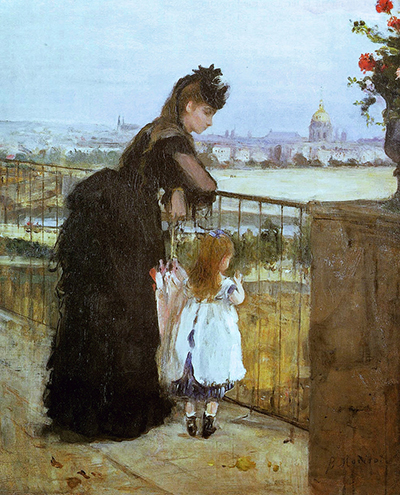Known as one of the three great female painters of Impressionism in her lifetime, Berthe Morisot was a perfectionist, displeased with and destroying much of her oeuvre as she worked and perfected her craft.
Because of this tendency to hide her mistakes, her progress as an artist cannot be accurately gauged: however, it is known that as the child of a relatively wealthy family, she would have received art lessons, progressing from pencil to watercolour to oils. It is known that she doubted her prowess with oils and clung to watercolours for quite some time, even when her clear skill was apparent.
This painting, aptly called Woman and Child on the Balcony, or just On the Balcony, is one such example: in watercolour paints, with touches of gouache, the paint applied over a graphite sketch and the whole on off-white wove paper. The subjects of the painting are a woman and child who are standing on a balcony, looking out over a splendid view – much of which is hidden from the viewer by a wall. The view we can see stretches off into the distance, the impression of distance offered by the scale of far-off buildings that manage to convey the knowledge that they are large, important edifices.
The composition of the painting is interesting. Morisot has used the 'rule of thirds', but in a quirky way, the middle third of the painting formed into a diagonal by the balcony's guardrail which angles down to the right across the middle of the image. The child, ethereal in white smock is centred on the bottom two-thirds of the picture, while the woman bends, leaning on the railing and – apparently coincidentally – curving over the child protectively.
The location can be extrapolated from the clearly recognisable dome of Sacre-Coeur in Montmartre. The two figures are positioned in such a way that the eye is drawn to the golden dome, perhaps an acknowledgement of the meaning behind the image: as much can be extrapolated from the painting. The woman is wearing black from head to foot, which could be an expression of mourning. A hint that this is an accurate reading can be seen on the child who is also dressed sombrely underneath the white of her smock.
The umbrella, which is placed between them could be symbolic of a time of tears and distress – these taken with the subtle drawing of the attention to the church, could imply that the woman and child are freshly bereaved, while the hint of youth, the glimpse of bare arms under the sheer sleeves of the woman's dress, perhaps indicate a free and independent spirit. In fact, Morisot herself was in mourning at the time of painting: her father passed away in 1872, and his passing marked the beginning of her mature phase. She would soon re-attempt oil paints, with greater confidence and her career would take off to make her one of the more successful artists – male or female – of her time.




